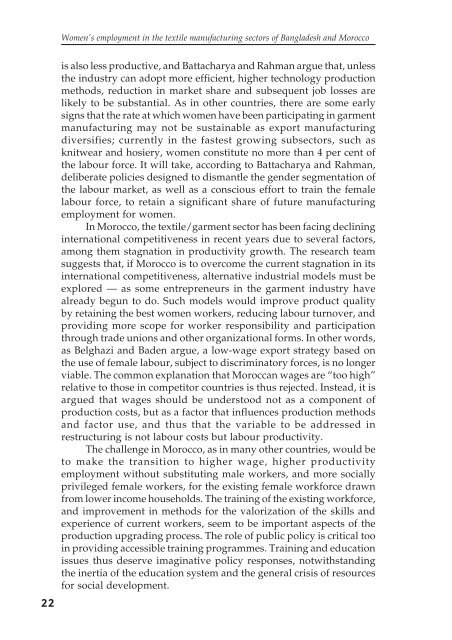Women's Employment - United Nations Research Institute for Social ...
Women's Employment - United Nations Research Institute for Social ...
Women's Employment - United Nations Research Institute for Social ...
Create successful ePaper yourself
Turn your PDF publications into a flip-book with our unique Google optimized e-Paper software.
Women’s employment in the textile manufacturing sectors of Bangladesh and Morocco<br />
22<br />
is also less productive, and Battacharya and Rahman argue that, unless<br />
the industry can adopt more efficient, higher technology production<br />
methods, reduction in market share and subsequent job losses are<br />
likely to be substantial. As in other countries, there are some early<br />
signs that the rate at which women have been participating in garment<br />
manufacturing may not be sustainable as export manufacturing<br />
diversifies; currently in the fastest growing subsectors, such as<br />
knitwear and hosiery, women constitute no more than 4 per cent of<br />
the labour <strong>for</strong>ce. It will take, according to Battacharya and Rahman,<br />
deliberate policies designed to dismantle the gender segmentation of<br />
the labour market, as well as a conscious ef<strong>for</strong>t to train the female<br />
labour <strong>for</strong>ce, to retain a significant share of future manufacturing<br />
employment <strong>for</strong> women.<br />
In Morocco, the textile/garment sector has been facing declining<br />
international competitiveness in recent years due to several factors,<br />
among them stagnation in productivity growth. The research team<br />
suggests that, if Morocco is to overcome the current stagnation in its<br />
international competitiveness, alternative industrial models must be<br />
explored — as some entrepreneurs in the garment industry have<br />
already begun to do. Such models would improve product quality<br />
by retaining the best women workers, reducing labour turnover, and<br />
providing more scope <strong>for</strong> worker responsibility and participation<br />
through trade unions and other organizational <strong>for</strong>ms. In other words,<br />
as Belghazi and Baden argue, a low-wage export strategy based on<br />
the use of female labour, subject to discriminatory <strong>for</strong>ces, is no longer<br />
viable. The common explanation that Moroccan wages are “too high”<br />
relative to those in competitor countries is thus rejected. Instead, it is<br />
argued that wages should be understood not as a component of<br />
production costs, but as a factor that influences production methods<br />
and factor use, and thus that the variable to be addressed in<br />
restructuring is not labour costs but labour productivity.<br />
The challenge in Morocco, as in many other countries, would be<br />
to make the transition to higher wage, higher productivity<br />
employment without substituting male workers, and more socially<br />
privileged female workers, <strong>for</strong> the existing female work<strong>for</strong>ce drawn<br />
from lower income households. The training of the existing work<strong>for</strong>ce,<br />
and improvement in methods <strong>for</strong> the valorization of the skills and<br />
experience of current workers, seem to be important aspects of the<br />
production upgrading process. The role of public policy is critical too<br />
in providing accessible training programmes. Training and education<br />
issues thus deserve imaginative policy responses, notwithstanding<br />
the inertia of the education system and the general crisis of resources<br />
<strong>for</strong> social development.
















